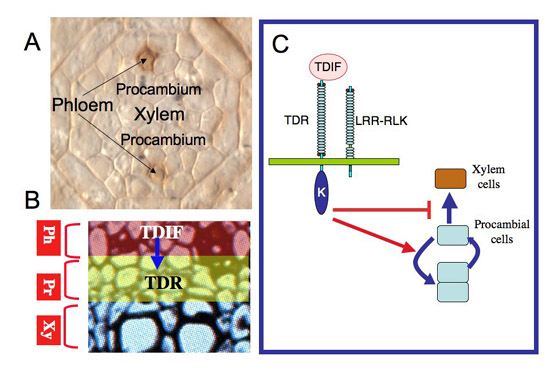Non-cell-autonomous control of vascular stem cell fate by a CLE peptide/receptor system
Land plants evolved a long-distance transport system of water and nutrients composed of the xylem and phloem, both of which are generated from the procambium and cambium comprising vascular stem cells. However, little is known about the molecular mechanism of cell communication governing xylem-phloem patterning. We recently isolated the CLE peptide TDIF (Tracheary element Differentiation Inhibitory Factor, HEVHypSGHypNPISN) from a xylogenic Zinnia cell culture and showed that this TDIF can suppress the differentiation of cultured cells into the tracheary element, a component of the xylem in culture (Ito et al., Science 313, 842-, 2006).
Here, we succeeded in the identification of the receptor for TDIF, which belonged to the leucine-rich repeat receptor-like kinase (LRR-RLK) family and was designated TDR (putative TDIF receptor). The combined analysis of TDIF with a specific antibody and the expression profiles of the genes encoding TDIF and TDR revealed that TDIF is synthesized mainly in, and secreted from, the phloem and its neighboring cells (Fig. 1A), and that TDIF is perceived through TDR in procambial cells where the TDR gene is specifically expressed (Fig. 1B). Excess TDIF/TDR signaling caused promoting proliferation of procambial cells while suppressing xylem differentiation. In contrast, the suppression of TDIF/TDR signal resulted in reduced procambial cells. Therefore this small peptide functions as a phloem-derived non-cell-autonomous signal that promotes maintenance of procambial cells through proliferation while inhibiting their differentiation into xylem cells (Fig. 1C). Our finding is the first indication of cell–cell communication being critical between xylem and phloem cells to form organized vascular tissues.
Program member
Hiroo Fukuda (Department of Biological Sciences, Graduate School of Science)

The cell-autonomous TDIF/TDR signal regulates the fate of procambial cells.
A. Immunohistochemical localization of the TDIF peptide in the root tip. Note that the signal is detected around the phloem cells. B. TDIF produced by phloem cells moves to procambial cells. C. A model of the TDIF/TDR signaling system, which promotes cell proliferation of procambial cells and suppresses differentiation into xylem cells from procambial cells.
